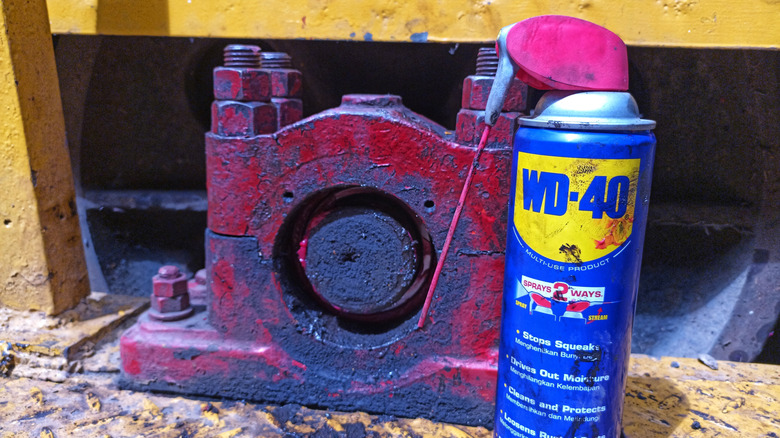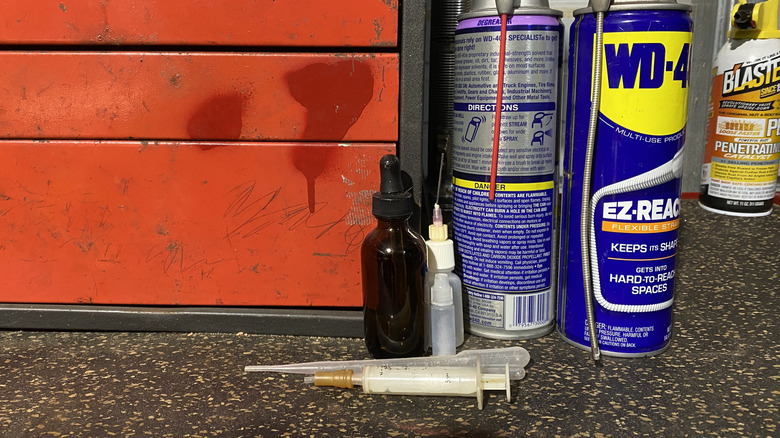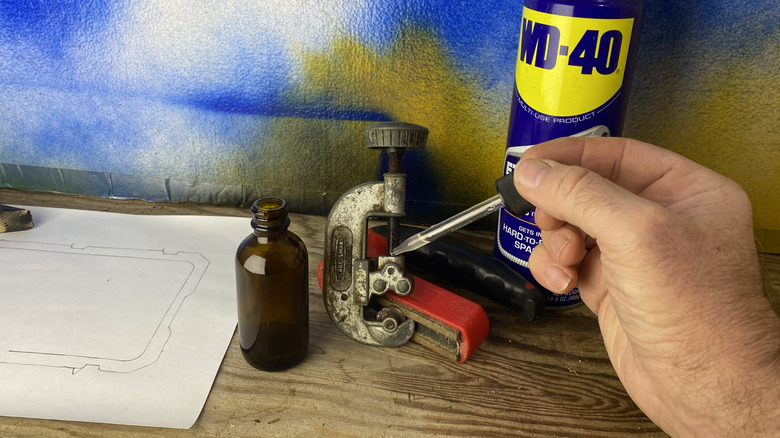A Handyman Shares A No-Mess Tip For Using WD-40
We may receive a commission on purchases made from links.
I'm not trying to start trouble. But I am about to trigger a fairly large number of people by claiming that WD-40 is a lubricant. Next thing you know, I'll be telling people to use it in places that WD-40 should not be used in and around the home. But it is a lubricant, and that's why when you accidentally overspray it onto your windshield or your eyeglasses or, heaven forbid, a smooth floor, you're in for fun times. And here's the rub: You will almost always overspray WD-40. But it doesn't have to be that way.
The trick to avoiding the unholy mess of WD-40 overspray is simple: Don't spray it. This truth became evident to me when the company issued its first No-Mess Pen, which transfers the stuff by simple contact. But what if all you have is a spray can? If you're lucky, you have a removable cap you can spray some into; but if you have a spray can with no cap, there's still hope.
Before we dive into the finer points of not spraying WD-40, let's admit right up front that the WD-40-is-not-a-lubricant posse triggered above is correct to some extent. It's a poor (and temporary) lubricant, and there are better choices if lubrication is your goal. But when the carbon dioxide has blown it out of the can and the lighter hydrocarbon solvents have evaporated, you're left with mineral oil on your floor and everything else in sight. WD-40 can be used for hundreds of things, and one of its less popular uses is making you skate comically across your tile floor. That's definitely lubrication at work.
How to not spray WD-40
Think of WD-40 as if it were paint. You can buy a can of spray paint and apply it indiscriminately to whatever's in front of you, or you can buy a can of paint and use tools to put the stuff where you want it. And while you can buy WD-40 in a propellant-free liquid form, you probably have a spray can like everyone else. If you're lucky, your can has a little red cap, and you can spray the WD-40 into the cap and dispense it from there. Now, without even taking a step, you're halfway to eliminating your usual WD-40 mess.
What's that? You lost your red cap? Yeah, everyone does that. And those that don't lose the cap didn't have one in the first place, but instead have something like an EZ-Reach or Smart Straw can. These integrate the iconic red WD-40 straw so that you can't lose it when you lose the cap, and so you can continue to be very focused about where you direct your overspray.
Fortunately, you can spray it into other containers. I am partial to condiment cups, which I use to temporarily hold everything from paint to wood glue to two-part epoxy. Note, however, that the hydrocarbons in WD-40 can embrittle, weaken, or even disintegrate plastics like polystyrene foam, polycarbonates, and PVC (which is why you should use it with care if you clean your vinyl floors with WD-40 and never use WD-40 on your plastic drawers). My condiment cups of choice are polypropylene; if you're unsure about yours, use a non-clear plastic to be on the safe side.
Dispensing with traditional WD-40 dispensers
Pouring WD-40 on something is nearly as messy as spraying it, so now what you need is some kind of dispensing tool. I've used many things over the years, and all of them work as well as the others. I've used little dropper bottles (think eyedrop bottles), pipettes, and children's oral syringes. If you buy luer lock syringes, tons of non-medical doodads can be twisted onto them for dispensing lubricants. Metal blunt-tip dispensing needles ($11.89) won't puncture anyone unless you're trying really hard, and plastic glue-dispensing nozzles look promising. Luer lock connectors can be found on squeeze bottles, and I find squeeze bottles with blunt needles attached to be perfect for precisely dispensing glue and pretty good for dispensing WD-40. There are also flexible polypropylene luer lock needles, which are even safer than the blunt variety.
Ultimately, tons of things will do the trick. You could probably use a meat injector syringe to great effect, but I haven't tried it. But considering the possibility of encountering a plastic incompatible with WD-40, it might be wise to avoid plastics altogether. Syringes, for example, are typically made of polypropylene, but if you're buying non-medical syringes from some unknown supplier on Amazon, you might end up with something WD-40 will happily dissolve for you. Ultimately, I think my favorite is the simple glass dropper bottle ($5.99 for four bottles, labels, and a stainless funnel). But all you really need is the dropper and that red WD-40 cap, or something like it. Don't overthink it, but do stop spraying it all over the place.


